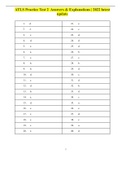Exam (elaborations)
ATLS Practice Test 2 Answers & Explanations | 2022 latest update
- Course
- Institution
ATLS Practice Test 2 Answers & Explanations | 2022 latest update 1. d. 21. e. 2. a. 22. c. 3. c. 23. d. 4. d. 24. d. 5. e. 25. d. 6. a. 26. b. 7. c. 27. c. 8. b. 28. b. 9. b. 29. d. 10. d. 30. c. 11. c. 31. d. 12. d. 32. b. 13. b. 33. d. 14. a. 34. c. 15. d. 35. a. 16. e. 36. e...
[Show more]



